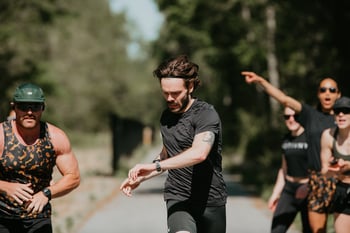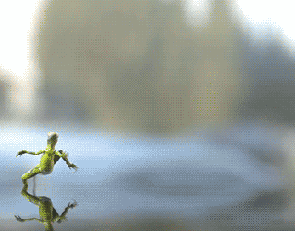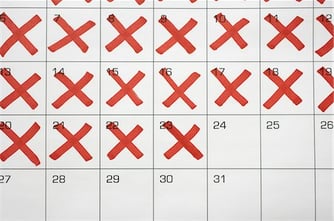Why Do I Have Foot Pain While Running?
July 31, 2023
This Spring all of your friends decided to get into a health kick. You all bought your freshest new runners from Salomon or Nike, kitted up with gels, electrolytes, and snacks for your Saturday long run, and booked it into the calendar -- 11 miles Saturday morning...MOTIVNY to Prospect Park for a loop and then brunch.
You take off with a huge grin on your face, exhilarated to be out with your crew at an "easy pace" and start to notice as you sit down with your first mimosa...your feet hurt like HELL. So what's up with that? Below, we'll take you through some quick hits of why, where, and when your feet hurt and brief thoughts on what to do about it.
1. YOU RAMPED UP TOO QUICKLY

We've all been there...your bestie is training for a race one month before yours and you still want to run together. But she's out for 14 miles and you're only up to 10. So do you go out for the 14 anyway just to hang?
A good rule of thumb is to avoid increasing your longest weekly run by more than 1-2 miles from the previous week and to avoid an increase of more than 5 miles per week total.
2. SHOE CHOICE BIT YOU IN THE REAR
Super shoes, Carbon foot plates this, Vaporfly that, Adios Pro this, Endorphin that...what the heck does it all mean?
One common misconception of this new era of shoes is that faster means better. People need to get the message: Carbon plates in your shoes mean more stress on your feet, calves, and potentially joints. They may also leave the intrinsic muscles of the feet less active if they're all you're wearing to train.
You're really only meant to use these things for racing and a few practice runs. To make things worse, it's often confusing or not clearly noted what shoes have carbon in them and what they are for when it comes to training.
Check the details, and avoid running all of your training runs in carbon-plated shoes. (Check out another good article on this topic.)
3. A GAIT ANALYSIS MIGHT BE BENEFICIAL

So you must have flat feet right? Not necessarily. We find that people with overpronation (flattened arches), as well as people with under pronation (higher arches), can have pain in the inside arch.
As therapists, we tend to look more at how the foot is impacting the ground, the rate of pronation, and how the limb reacts to ground contact. If you hit the ground hard and have a very rapid rate of pronation, but your body isn't ready for that stress it becomes very easy to have foot pain on the inside arch. There are definitely other reasons this can happen, but this is one common one.
Chat with a MOTIVNY physical therapist or coach who can assess your gait and talk about your program.
4. YOUR SCHEDULE IS JACKED UP
 A lot of race training schedules call for 5 days a week of running. That can work for people who are experienced and healthy, but if you're newer to running or have come across pain when you run, it's probably best to start somewhere closer to 3 days a week and consider racing shorter before you tackle the marathon distances. You can also explore breaking up your long run into two runs on the same day. This helps athletes who aren't enduring the ground contact volume.
A lot of race training schedules call for 5 days a week of running. That can work for people who are experienced and healthy, but if you're newer to running or have come across pain when you run, it's probably best to start somewhere closer to 3 days a week and consider racing shorter before you tackle the marathon distances. You can also explore breaking up your long run into two runs on the same day. This helps athletes who aren't enduring the ground contact volume.
5. YOU'RE MISSING THE CORE FUNCTION OF THE FEET
You might have heard of toe yoga. Yes, it is a real thing, and yes, it is really useful. A lot of us have spent WAYYY too much time in shoes, and our feet have suffered for it. In order to build strength and endurance in your feet when you run, you'll need them to be active in the first place.
Here are 3 core moves you should expect to have:
- Lift the 4 small toes while pressing the big toe down into the ground. If your arch collapses you're actually using your ankle to press the ground. You need to be able to do both. Practice as often as possible.
- Spread all of your toes without flexing or extending them. If your toes are all jammed together, you'll have reduced function inside of your foot. You should be able to create at least a sharpie-sized space between all of your toes.
- Jump backwards and land on just your toes (heels never touch the ground). This demonstrates some reactive strength in the foot.
'
SO WHAT DO WE RECOMMEND?
Foot pain in runners is something we have come across so much and has been one big reason why we emphasize strength training in conjunction with running. A lot of you are probably selling yourselves short on speed and results because you're too focused on distance and not enough on your body capacity.
Talk to some of the crew in the MOTIVNY Outdoors classes or attendees of our Kettlebell Classes. It's important, and can often be the difference maker for people who have struggled with injuries or can't get faster.
Got questions? Hit me @lukemotiv on Instagram, or book in below to talk to one of our coaches.

LUKE GREENBERG
Manual Medicine, Kettlebells and Golf Training, Team Dad
